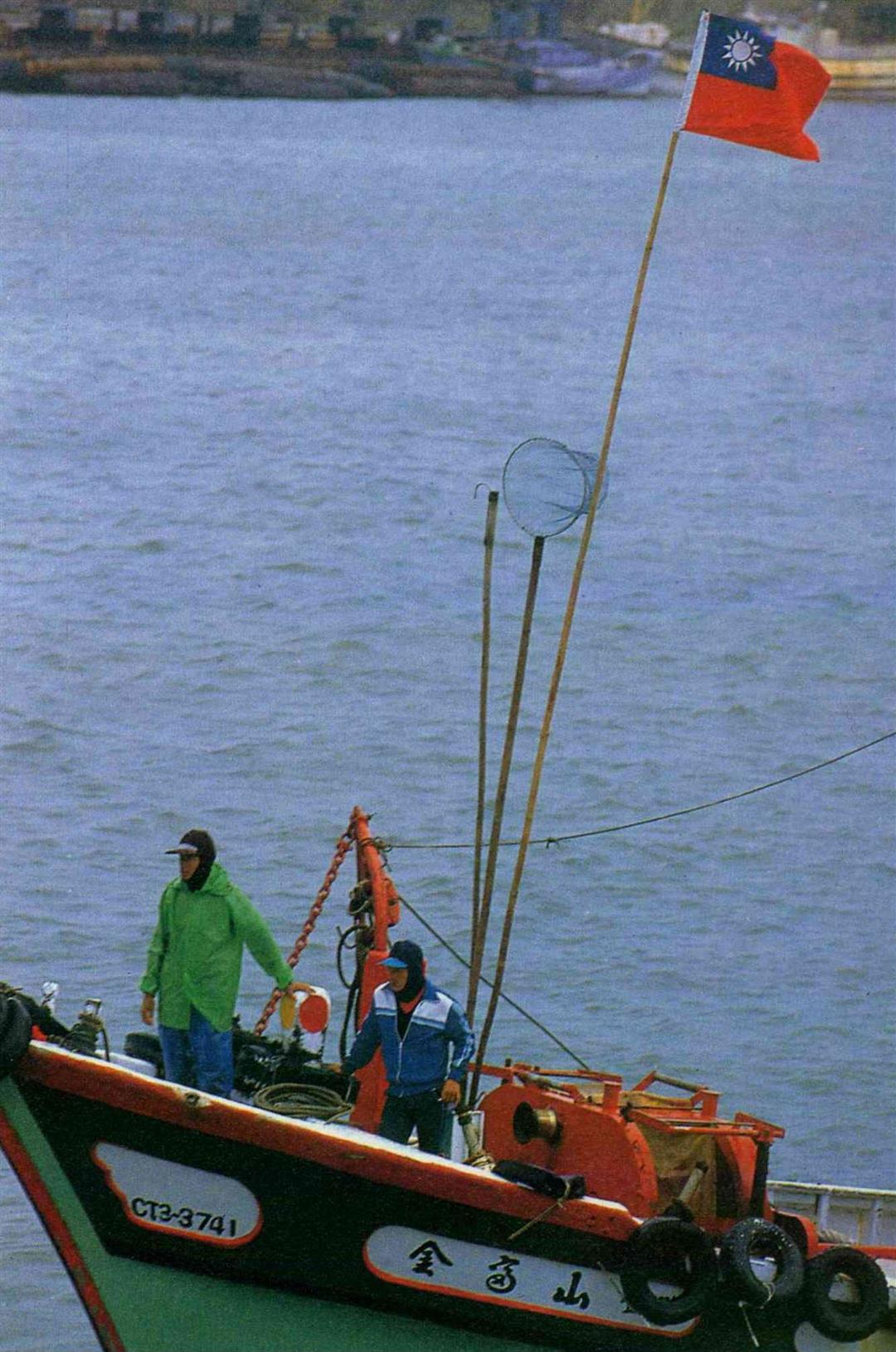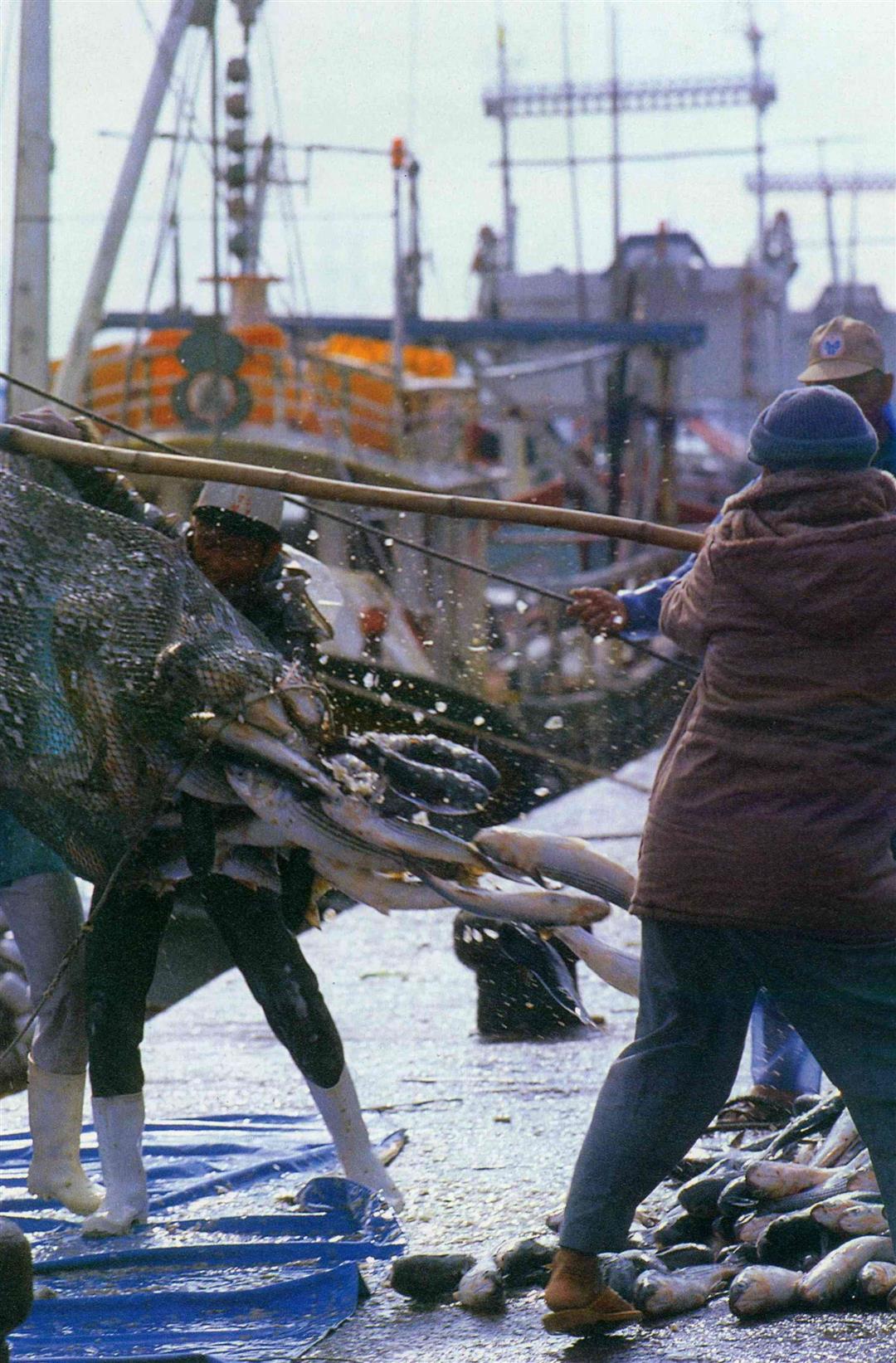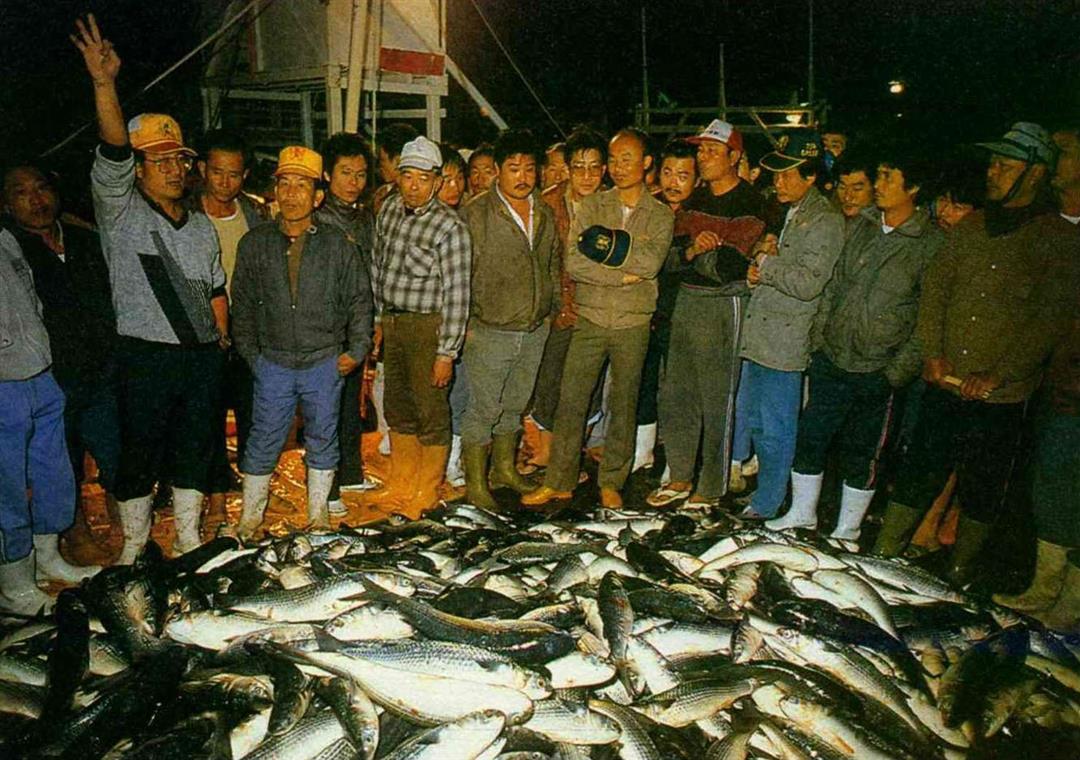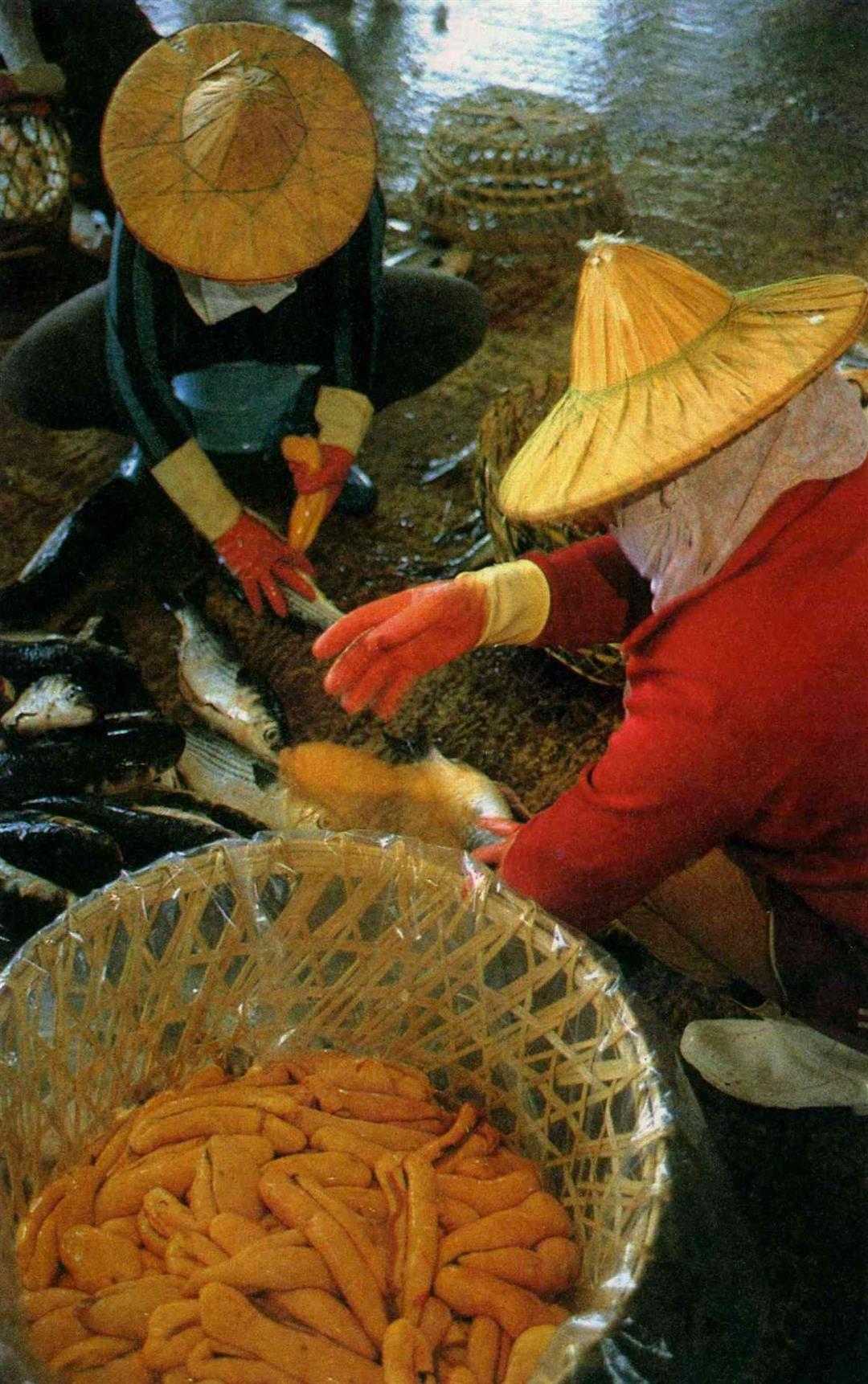One day a long time ago some fishermen from Chiehting Village in southwestern Taiwan were blessed with a catch of over 10,000 mullet. Elated, they hoisted an ROC flag in celebration. Ever since then, fishermen there have observed the unwritten rule of raising the flag for every catch of over 10,000, and a fluttering flag has become a longed-for sight with the fishermen's families.
Every year near the end of December, mullet congregate in the waters offshore southwestern Taiwan, and the fishermen of Chiehting go into action.
The peak of the catch comes in the two or three days before and after Christmas Eve. Two years ago at this time, 100,000 fish were caught each day--300,000 on December 26th alone.
Last year looked as though it might be a different story, however. Christmas Eve, Christmas, and the day after passed with only scattered catches and not a flag in sight. Finally, around noon on the 27th, word crackled in over the radio that the fish were running. When the Chinfushan No. 1 and No. 2 pulled into the harbor with their flags snapping, the spectators set off strings of firecrackers and exulted that "the bad luck's gone!"
As sacks and sacks of mullet were tossed onto the wharf, wholesalers who had come to bid on the fish crowded into the auction site. Inspecting the catch, they calculated, "They're fresh all right! But how many are females? And how high a price can I afford to bid?"
The high price of mullet is due chiefly to its eggs: mullet roe. Rich in protein and low in fat, mullet roe is considered as nutritious as it is delicious. Mother mullet make up about one-third of a school, and the roe contained in each mother are worth about NT$700 or NT$800 (about US$20 to US$23).
Mullet roe is a prized delicacy on Taiwan at wedding banquets, Chinese New Year's dinners, and other special occasions. It has also become a hot item in trade with Japan, where it is baked crisp and eaten with sake--to the tune of $8 million a year. Actually, mullet are also found in Japanese waters, but as soon as winter comes, they swim south to lay their eggs, so the Japanese have to import the roe from Taiwan.
Exactly when people on Taiwan began catching mullet is not known. According to a travel journal written over 230 years ago by the mainlander Tung T'ien-kung, "Every year before the winter solstice, mullet swim from Changhua and Lukang to Phoenix Mountain County [today's Hengchun], lay their eggs in stony cracks at the sea's foot, and then return north. . . ."
Perhaps fishermen were catching mullet even earlier than that. They may not have known where the fish came from, but they knew that they arrived on time each year, and so they called them hsin yu, or "trusty fish." Other names were "divine fish" or "God's fish," because the fish were believed to be a gift from Heaven. One of the divinities worshipped in early Taiwan fishing villages was the Water Fairy King, who was said to send the fish every year in thanks for the people's offerings.
When Tung T'ien-kung came to Taiwan, the prevailing method of catching mullet was by "jump catching." The fishermen would row out bamboo rafts with surrounding nets to where the fish were and beat the water with wooden poles. Frightened, the fish would jump out of the water, and some of them would land in the nets. Catches were small and the rafts often fell victim to the December winds and waves, so this method of catching fish has long since died out.
Chiehting Village, which is a drive of about an hour and a half from Kaohsiung, is Taiwan's largest mullet market, last year accounting for some 60 percent of the island's total catch and for sales of over NT$100 million. More than 90 percent of the fish there are caught with huge trawling nets, called "Great Walls of the sea," measuring 800 meters long and 100 deep. The record catch with one net is 70,000.
At present, Chiehting has over seventy teams of trawlers, each team consisting of two boats. Receipts are divided equally between owners and crew.
The boats cost nearly NT$10 million each. Besides the huge nets, they are also equipped with two-way radios and advanced detection equipment to locate fish schools. But experienced fishermen say they have a sixth sense to find the fish. "Sea birds on the wing, floating wood, or trash--a patch of silvery white on the sea in the day or a glowing red patch at night--these signs mean mullet," an old captain asserts.
Explaining the signs scientifically, a researcher at the Taiwan Fisheries Research Institute says, "Mullet like to eat refuse, so they 'seek odors.' And their scales are phosphorescent, flashing silver in the day and red at night."
In fact, marine biologists know quite a bit about mullet, their habits and migratory patterns. The home of the fish is the lower reaches of the Yellow River and the mixed salt- and freshwater sea area at its outlet. According to the fisheries research institute, the temperature (20 to 23 C.) and salinity (32.5 parts to 1,000) of the waters off the west coast of Taiwan happen to be ideally suited for the fish to lay their eggs, and so local fishermen are blessed with their annual visitations.
Mullet roe has always been considered an expensive delicacy, but this year it's going to cost connoisseurs even more than in the past. That's because last year's catch was just 800,000, the first time in a decade the total has fallen below one million.
Most marine biologists believe that last year's warm winter was to blame, making the fish stay farther offshore and several hundreds of meters deep to find suitable temperatures. But some worry that over-catching may also be a problem. Competition is intense, and the number of boats is increasing while their the equipment is growing more sophisticated. Experts urge the fishermen not to catch the younger fish to allow the population to replenish itself.
Meanwhile, the mullet continue to keep their punctual appointment with Taiwan each year. Shouldn't people keep up their part of the bargain, too?
[Picture Caption]
Raising the flag makes the fishermen happy. It means at least NT$2 million in their pockets.
"One, two, three, heave!" Sack after sack of mullet are tossed on the wharf.
Bidding for the freshly caught mullet is about to begin.
Removing the roe is a delicate operation. A break in the membrane sac will cause the eggs to leak out, ruining the price.
After salination, the roe is pressed between boards layered with cloth to absorb excess moisture.
Bright orange mullet roe is a favorite gift of businessmen to their clients to build good relations.

Raising the flag makes the fishermen happy. It means at least NT$2 million in their pockets.

"One, two, three, heave!" Sack after sack of mullet are tossed on the wharf.

Bidding for the freshly caught mullet is about to begin.

Removing the roe is a delicate operation. A break in the membrane sac will cause the eggs to leak out, ruining the price.

After salination, the roe is pressed between boards layered with cloth to absorb excess moisture.

Bright orange mullet roe is a favorite gift of businessmen to their clients to build good relations.